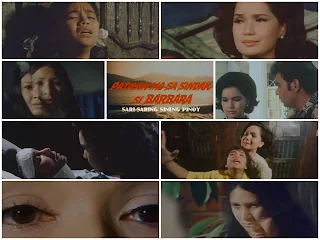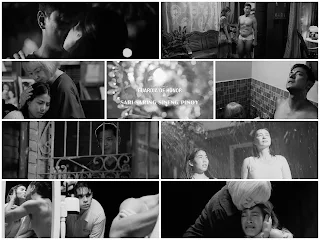There are two lines of thought that dominate any discussion of what makes a movie scary: either it is a great deal of subtlety and implication that allows the viewer to imagine all sorts of terrible things just out of sight or it is being explicit in the most hideous, disconcerting way possible. It is the difference between a creepy ghost story and a bloody slasher flick; I think it's not an undue generalization to suggest that the side any given person comes down on is going to be reflected in their age. Strip away all of its frightening elements, Patayin Mo sa Sindak si Barbara (Rosas Productions, 1974) remains a sophisticated, complex and tremendously subtle character study. Director Celso Ad. Castillo knows to trust his actors to sell the material, starting with Susan Roces who gives a spectacular performance both thrilling and heartbreaking. Emotions are manifested in camera movement, as when Barbara (Roces) and Fritz (Dante Rivero) suspect something horrifying going on inside Karen's (Beth Manlongat) bedroom. Castillo gets a scare from shifting the light-source to cast face-shaped shadows on mirrors. Patayin Mo sa Sindak si Barbara is yet another film ill-served by pan and scan television prints. Castillo brilliantly uses widescreen to strand his characters in odd-shaped rooms or corridors, making the watcher's eye skitter frantically over the screen to catch every ingeniously rendered detail. Rivero's Fritz is self-assured and a little smug. Rosanna Ortiz is especially good at revealing the stubborn strengths that lie within Ruth and makes her, in the end a danger both to Barbara and daughter Karen.
The real crux of Patayin Mo sa Sindak si Barbara isn’t so much Ruth's hauntings – although these are among the most effective ever committed to film – but the unravelling of her relationship with Barbara. For every action in the film there is a justifiable excuse. Even upon the film’s conclusion, no formulaic reason is given — only suggestions. Patayin Mo sa Sindak si Barbara is fifty years old and it persists to be as effective and scary as any rendition of the same concept. With its stark compositions, sudden camera movements and odd perspectives, Castillo’s film owes much to Master Filmmaker Gerardo de Leon and the restoration work shows this debt off beautifully. There’s a touch of inadvertent grain only very infrequently, but for the lenses that Castillo used and the associated occasional softness of the focusing, everything looks wonderfully sharp, really bringing out the mood of the movie. There are some vertical lines that occasionally pop up. Tiny flecks can be spotted as well. Detail and image depth however, are very pleasing. Generally speaking, contrast levels also remain stable throughout the film. It’s probably beneficial that the audio has been left in the original mono. Any attempt to improve it would surely have ruined the effect. Once free of the overused internal monologues, Castillo dedicates the rest of the movie to establishing genuine fear that's punctuated with carefully timed shocks. Pretty soon, you've forgotten about the slow start and have entered a startling film that still retains effective tension. You might not have a lot of answers by the end but you'll find various scenes stay with you long after the movie is over.
Directed By: Celso Ad. Castillo
Film Editor: Augusto Salvador
Sound Supervision: Angel P. Avellana, Jun Ella
Director of Photography: Ricardo Remias, F.S.C.
Screenplay By; Mike Relon Makiling
Music By: Ernani Cuenco










